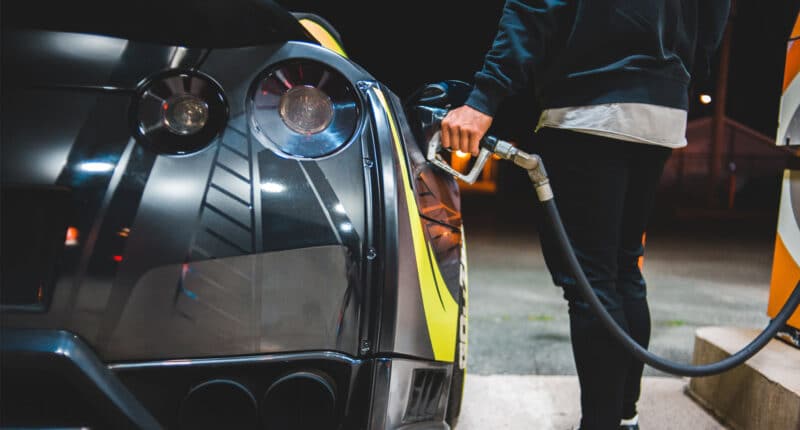Talk about controversies in the automotive world and the topic of octane boosters will certainly come up. There’s a lot of ambiguity out there about these products, and for good reason.
Tall claims by manufacturers and conflicting independent test results add fuel to the fire. Pun intended.
You’re probably wondering — why then do many car enthusiasts use and even swear by octane boosters? The simple answer is that it works for some people and for others, it just doesn’t.
It all comes down to what car you drive, the kind of fuel you have available to you, and how your engine is tuned.
The standard North American gas station offers 3 grades of fuel — 87 octane, 89 octane, and 93 octane. Those options exist because different cars are designed to run on different grades of fuel.
Let’s consider two extreme examples here. If you pour 93 octane in a Corolla, it will do zilch. But if you use 87 octane fuel in a high-compression (11.0:1) F20C Honda S2000 that’s designed to run on 93, it will most likely create problems.
Many people think that “octane” represents the gasoline’s power density, and make a correlation that high octane equals high horsepower. This is incorrect. High octane gas alone cannot yield more power unless it’s preventing detonation. More on that later in this article.
In this guide, we’ll explain what an octane booster is, what it does, and whether you should use it or not. We’ll also list some of our top recommendations — your search for the best octane booster ends here.
What Does Octane Booster Do? Does It Work?

Octane boosters are fuel additives that are designed to increase the octane rating of the fuel you’re using. Before we get into more detail, let’s understand what “octane” means in the context of fuel.
Octane refers to the amount of heat and pressure that fuel can withstand before burning. In other words, it’s the fuel’s resistance to combustion.
But then, why are octane boosters designed to increase your fuel’s octane rating? To make more power, wouldn’t you want your fuel to be easily flammable? In that case, shouldn’t you be chasing lower octane numbers?
It’s a little more complicated than that. Allow us to explain.
You’re probably aware of engine knock — you know, that weird pinging sound that your engine sometimes makes? It’s almost like something’s knocking on the inner walls of your engine cylinder.
This happens because of the uneven burning of fuel inside your combustion chamber. Let’s take a closer look at why this happens.
Engine Knocking and Pre-Ignition Explained
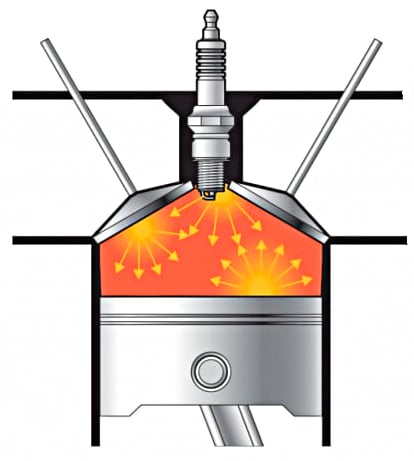
The internal combustion engine is basically a high-pressure air pump. The four-stroke cycle (intake, compression, combustion, and exhaust) will ring a few bells. We’ve covered this in our exhaust systems explained article.
During the compression stroke, when the spark plugs ignite the compressed air-fuel mixture, the high-temperature and high-pressure exerted within the chamber sometimes results in a spontaneous 2nd combustion which is outside the boundary layer of normal combustion.
This is called “knock” or “detonation” — a supersonic (faster than the speed of sound) shock wave. These shockwaves resonate throughout the engine cylinder and create the characteristic “knocking” sound.
Knocking or detonation is bad for your engine. It can severely damage your pistons and hurt engine performance. Knocking can also lead to pre-ignition.

This is similar to detonation, except that it occurs before the spark plug fires. This can also happen when a carbon ember ignites the fuel-air mixture even when the piston is very early in the compression stroke — this is even worse than knocking and can cause more damage.
High temperature and high pressure are the main culprits behind engine knock and pre-ignition. This is a common problem with gasoline engines because they compress both air and fuel at the same time.
Fun fact: That’s why knock isn’t a big issue with diesel engines — they compress just the air first, and add fuel later only when it’s hot enough.
Not all gasoline engines are prone to knocking though. Low-compression engines used in economy cars aren’t plagued with knocking issues unlike high-compression engines in performance cars — especially if they’re high-compression and turbocharged or supercharged.
More compression = higher temperatures = more knock.
The best way to avoid knock is to prevent the air that enters the engine from getting too hot. But that’s unrealistic. We can’t rely on the weather for our engines to work correctly, and your radiator can only do so much. Luckily for us, there are better solutions:
- High octane-rated fuel, and
- Octane boosters.
As mentioned before, high octane fuels are more resistant to combustion.
If for whatever reason, you don’t have high octane fuel available to you on a regular basis, and if your car is designed to run only this type of fuel, you can use an octane booster instead.
What Type of Cars Respond to Octane Booster?
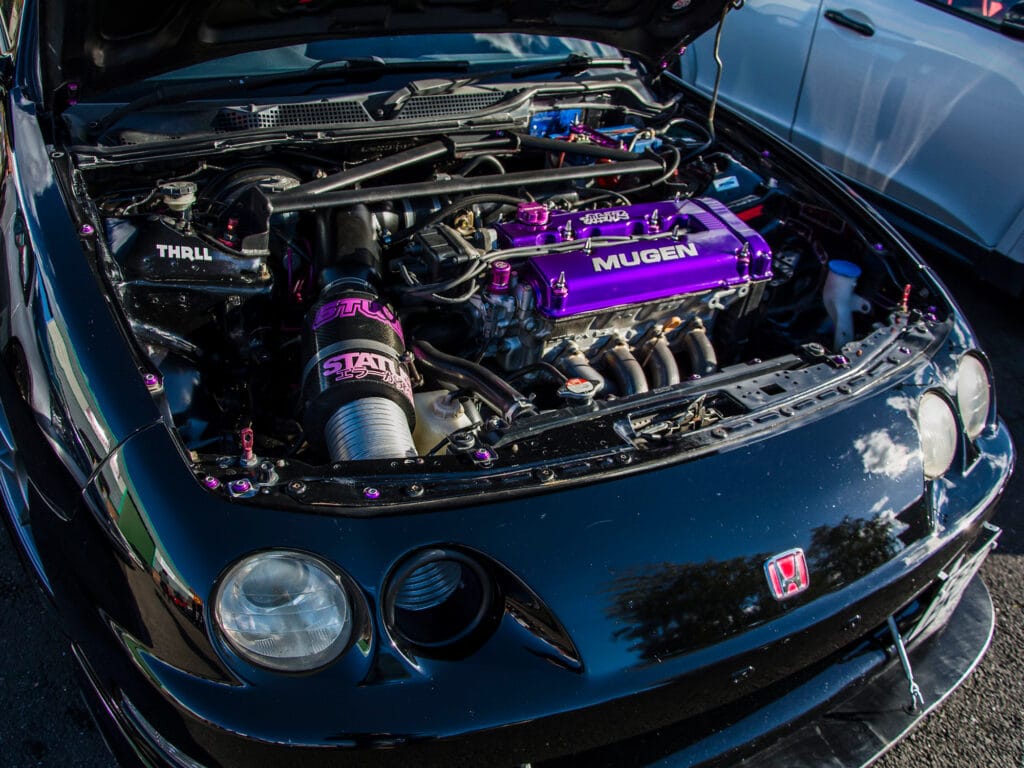
It’s usually the high-performance, high-compression cars that get the most out of octane boosters, especially when you drive them in areas where premium gas isn’t available.
For instance, cars designed for 97 or 104 octane will not drive correctly if you fill them up with 87 octane, and it could result in engine knocking.
However, many performance cars that are designed to run on higher octane fuel can also work with premium unleaded petrol. This is made possible thanks to adaptive ECUs and knock sensors.
With that in mind, octane boosters need to be thought of as a preventative maintenance measure, and not as a means of adding more power. The only scenario where these could add more power is if you’ve been using lower octane fuel in a car that’s tuned to run higher octane fuel.
Another prominent use case for octane boosters is for those who drive tuned and modified cars.
This is a very broad subject, but to give you an example, if you’ve turbocharged your Nissan 350z, installed bigger fuel injectors, an upgraded engine management system, a cold air intake and aftermarket exhaust system, chances are that your car has also been tuned to take high octane fuel.
In a scenario like this, an octane booster can be used to get peak performance. But it cannot add power all by itself.
A quick note on how to use octane booster — you can use these either regularly or periodically depending on the availability of premium fuel. It’s always a good idea to pour the booster in first before filling up. This will ensure that it mixes properly.
What Do Gasoline Octane Boosters Contain?

Octane boosters and fuel additives, in general, are dime a dozen. There’s an overwhelmingly large amount of options out there.
All gasoline and diesel fuel additives sold in the United States are required to be registered in accordance with the Environmental Protection Agency. Each time a new ingredient is added, it needs to be registered. And the list is seemingly endless.
To make things easier, we’ll list some of the most common additives that you can keep an eye out for, along with what they do and how good or bad they are.
Aromatic Alcohols
Aromatic alcohols are effective when it comes to increasing the octane rating of fuels. The only downside is that they need to be used in large quantities (10%) to see a noticeable difference in the octane rating.
Another problem with aromatic alcohols is that the chemicals they contain are highly carcinogenic (cancer-causing), and they are easily absorbed in the skin. These include:
- Toluene
- Xylene
- Benzine, and more.
Extreme care must be taken when working with octane boosters that contain aromatic alcohol and contact with the skin must be avoided.
MMT
MMT or Methylcyclopentadienyl Manganese Tricarbonyl (quite a mouthful), is used not only in car engines but also in refineries all over the world. It’s way more environmentally friendly than other additives and isn’t harmful to emission control devices.
Octane boosters enriched with MMT are known to work really well — this is the stuff you want to see in your octane booster.
Ferrocene
Ferrocene is a cheaper alternative to MMT. Very few octane boosters these days contain this additive, and for good reason — it’s an iron compound.
When it combusts, it forms iron oxide which is bad for your engine in the long run as it tends to prematurely wear out the internal components.
Methanol
People who own high-boost turbocharged cars are probably aware of the “water-meth” injection — a mixture of water and methanol directly in the intake air stream. This helps to cool down the air that enters the engine and minimizes engine knock.
Coal-based methanol is also seen in many fuel additives because of its ability to give a big octane boost Interestingly, methanol by itself has an extremely high octane rating.
Methanol and ethanol also burn cleaner and help emissions.
Ethanol
Ethanol is commonly used by race cars for several reasons that we won’t get into in this article, but here’s a gist — using ethanol requires your car to be tuned specifically for it as it will run lean when you use it.
It has major downsides if you don’t intend on emptying out your tank every few laps — it absorbs water from the air around it which can cause corrosion in the fuel system.
However, you will see that ethanol is often used in octane boosters in small quantities.
Best Rated Octane Boosters
Okay, enough tech talk. Let’s move on to the list you’re here for. Below we’ve listed some of the most popular, and some of our favorite octane boosters on the market.
Some of these aren’t just octane boosters, they also contain other additives that help clean out your fuel system and even your engine.
Royal Purple Max Boost

Manufacturer: Royal Purple
Part number: ROY11757
Item volume: 16 oz
Buy on: Amazon
Royal Purple Max Boost is one of the most prominent octane boosters on the market. With MMT as its main active ingredient, it’s known to work and provide results in suitable conditions.
Max Boost can raise your fuel’s octane rating by 30 points. It simultaneously cleans your engine, injectors, and even stabilizes the fuel so it lasts longer. Feel free to use it for engines equipped with carburetors, direct injection, port-fuel injection, and especially forced induction.
Max Boost is safe for oxygen sensors and it also protects against phosphorus poisoning of catalytic converters.
Just be careful when you’re handling this product because it is a thick liquid that may stain surfaces if you spill. You should also avoid exposing this product to direct sunlight because you don’t want to breathe in the fumes in case it starts evaporating.
Lucas Oil PK-12
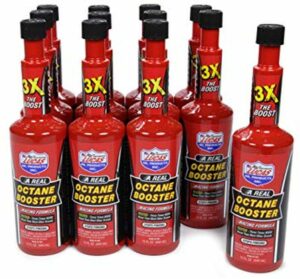
Manufacturer: Lucas
Part number: 10026
Item volume: 15 oz
Buy on: Amazon
PK-12 by Lucas Oil is rated for 30 points or 3 octane numbers. Each 15 oz bottle can handle up to 25 gallons of fuel. Note that this particular package is sold as a 12-pack.
This product is safe for turbos, oxygen sensors, and catalytic converters as it does not cause corrosion or oxidation thanks to MMT. It burns clean and is compatible with fuel-injected and carbureted engines too.
Be sure to check the manufacturer’s safety data sheet and technical data sheet for more specific information.
STP Octane Booster

Manufacturer: STP
Part number: 78574
Item volume: 5.25 oz
Buy on: Amazon
STP is one of the oldest names in the automotive fuel additives industry. They’ve designed their octane booster to do two things — boost octane and clean the fuel-intake system. Besides helping to reduce engine knock and pinging, it helps to restore performance by removing gunked-up carbon deposits.
This product is an affordable alternative to other octane boosters. It can treat up to 21 gallons from the 5.25 oz bottle. If you want to treat up to 28 gallons, you can opt for the 12 oz bottle.
STP recommends regular use for best results. Another major advantage is that the STP octane booster is compatible with capless gas systems.
Race Gas Race Fuel Concentrate
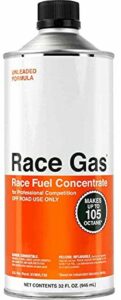
Manufacturer: Race Gas
Part number: 100032
Item volume: 32 oz
Buy on: Amazon
Race Gas fuel concentrate is a premium product containing 32 oz of octane-boosting goodness. This product is laboratory-proven to increase octane ratings and oxygen levels of pump gas to equal race fuel.
It contains the highest quality MMT along with fuel hydrocarbons and non-alcohol-derived oxygenates to ensure zero deposits along with efficient combustion.
It’s capable of increasing fuel rating up to 40 points or 4 full numbers — that’s up to 104 octane. Here’s the mixing ratio:
- 8 oz transforms 1 gal. of 93 Octane into 105 Octane
- 8 oz transforms 1 gal. of 91 Octane into 102 Octane
- 8 oz Gas transforms 1 gal. of 87 Octane into 100 Octane
Like others in this list, you can also use it in various vehicles such as motorcycles, go-karts, boats, jet-skis, and snowmobiles.
Gold Eagle 104+

Manufacturer: Gold Eagle Co.
Part number: 10406
Item volume: 16 oz
Buy on: Amazon
104+ is an affordable product by Gold Eagle that cleans fuel injectors and reduces knocks, pings, and throttle hesitation.
It’s perfectly safe for catalytic converters and oxygen sensors. The bottle contains 16 oz of octane booster which can treat up to 18 gallons of gas. Expect to see a mild bump in gas mileage too.
You can use 104+ with various gasoline blends including ethanol. This product is more suitable for regular street use and is not a race-grade octane booster.
Rislone Hy-Per Fuel

Manufacturer: Rislone
Part number: 4747
Item volume: 6 oz
Buy on: Amazon
Rislone is among the first-ever automotive chemical additives ever used, introduced way back in 1921. With over 90 years of experience under their belt, it’s safe to say that this company knows a thing or two about making quality fuel additives.
The Hy-per Fuel octane booster bottle only looks tiny but isn’t. This 6 oz bottle can treat up to 20 gallons of gasoline. It can also be used with gas that contains ethanol (E10 and E15).
The user-friendly nozzle makes it easier to pour the contents into all types of fuel tanks — even capless. You don’t have to worry about this product harming your catalytic converter or oxygen sensor.
Rislone Hy-per Fuel can increase octane levels up to 20 points or 2 rating numbers. The formula used in this product works just as well on classic cars as it does on race vehicles.
Dyno-Tab Power Booster

Manufacturer: Chemplex Automotive Group
Part number: 45456-12pk
Item volume: 72 tablets
Buy on: Amazon
Dyno-tab Octane Booster is unlike anything else you’ll see on this list. This is because it’s not a liquid — it comes in a solid tablet form. These tablets dissolve quickly and the best part is that they sink in the fuel tank for easy mixing.
Each tab card consists of 6 tablets, and it’s sold as a 12-pack. Each tablet can treat 5 gallons and add up to 10 points. Use two tablets to add up to 17 points.
Dyno-tabs dissolve fully in 18 minutes and start working instantly. Regular octane boosters may contain up to 98% petroleum carrier fluid, but Dyno-tab doesn’t have any at all. The only downside is that it does not contain MMT.
The advantage of using tablets over liquids is that you don’t need to measure anything and there’s no mess or spillage-related safety risks. This product is perfect for vintage cars, and it works well to eliminate engine knock and ping.
K-100 G+
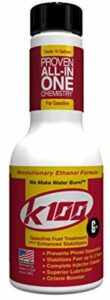
Manufacturer: K100
Part number: K100-G
Item volume: 8 oz
Buy on: Amazon
The K-100 G+ is truly the jack of all trades. It’s a revitalizer, stabilizer, and octane booster. Apart from reducing pinging and knocking, it also works to remove water from your fuel tank, dissolve varnishes, and treat fuel for extended storage.
It also works as a complete injector cleaner and serves as a superior lubricator. K-100 burns cleanly, with no ash deposits. Each 8oz bottle is capable of treating up to 16 gallons.
Gumout Octane Booster

Manufacturer: Gumout
Part number: 510022
Item volume: 10 oz
Buy on: Amazon
Gumout Octane Booster is a cheap and easy fix for vehicles that need higher octane fuel but don’t have it available. Apart from saving gas at the gas pump, you can expect this product to effectively prevent knocking and pinging.
This 10 oz bottle is capable of treating up to 15 gallons of fuel. It also burns clean and helps to reduce emissions.
Gumout works extremely well on high-compression engines and prevents detonation. The bottle is designed in a way that makes it easy to pour into your fuel tank without the risk of spillage.
Bardahl 3525

Manufacturer: Bardahl
Part number: 3525
Item volume: 5 oz
Buy on: Amazon
Bardahl is a two-in-one product that works as a fuel conditioner and an octane booster. It works to improve the quality of regular gasoline by adding detergents, and it increases the octane rating. Other than giving an octane boost, it also keeps injectors and intake valves clean to maintain power.
It even protects your tank and fuel lines from rust and corrosion. Besides improving your fuel economy, this product disperses water and decreases exhaust emissions.
The other benefits you’ll get from using this product are reduced stalling, smoother idling, and better driveability.
Prolong Fast Fuel

Manufacturer: Prolong Super Lubricants
Part number: PSL16030
Item volume: 12 oz
Buy on: Amazon
Prolong Super Lubricant is designed for race cars, but you can also use it on your daily driver. This product uses a formula that restores lost horsepower and also provides additional engine performance as it contains MMT.
It is engineered to not harm your O2 sensor or cat-con, so you need not worry about causing any harm to those components even if you’re using this octane booster regularly. Many customers swear by this product and its effectiveness.
What Is the Best Octane Booster?

Octane boosters are the kind of products where you really need to make sure that you choose the right one.
Even though all products listed in this guide are safe for your car, there are some out there that do more harm than good. Here are our top picks.
Best overall: Royal Purple
Royal Purple is arguably the highest-selling octane booster on the market. It’s powerful, safe to use, and doesn’t harm any components in your fueling and exhaust system. It does a great job at restoring power and effectively cleans deposits from your fuel injectors.
Budget-friendly: 104+
A 16 oz bottle of 104+ treats up to 18 gallons of gas. It cleans your injectors to boost performance and ensures that you get better gas mileage while reducing engine knocks and pings — all at an extremely competitive price.
Most professional octane booster: Race Gas
Race Gas is made in the USA and is specifically designed for competitive use. However, there’s nothing stopping you from using it for your daily driver as long as you’re emptying your tank on a regular basis.
And that concludes our list of the best octane boosters on the market.
What’s your experience with octane boosters? Do they work for you? Let us know in the comments below!
